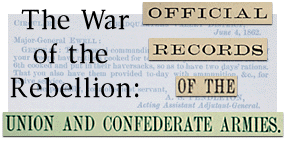Summary:
Union Cavalry Colonel Peter Stagg reports on February-March, 1865, actions in the
Shenandoah Valley. Stagg reports entering Staunton and destroying a nearby
railroad bridge.
Maj. A. E. DANA,
Assistant Adjutant-Gen.
Near White House, Va.,
March 22, 1865.
SIR:
I have the honor to submit the following report of operations of this brigade from the 27th day of February to the 18th day of March, 1865:
February 27, brigade broke camp at Camp Russell, va., at 5 a.m., and marched up the Valley pike, through Newtown, Middletown, Strasburg, and Woodstock, and encamped one mile and a half from that place. February 28, marched at 6 a.m. up the pike, through Mount Jackson, and encamped at Lacey's Spring. March 1, marched at 6 a.m. up the pike, and encamped within five miles of Staunton. At 8 p.m. I received orders to go through Staunton out on the Waynesborough road and burn the railroad bridge across Christian's Creek, five miles from Staunton. I was detained until after midnight by one of my regiments, which was on picket. I met with but slight opposition, although I found the enemy in small force within 1,000 yards of our lines. I intrusted the destruction of the bridge to Lieut. Col. G. R. Maxwell, First Michigan Cavalry, who with a dismounted force piled fence rails on the bridge. He being fearful the flames would not consume the timbers, as it was beginning to rain, cut the timbers with axes until the heat drove him away. After remaining here about an hour and a half I returned to Staunton. The corps then came up, and I moved with the division to near Fishersville and encamped. March 3, brigade moved at 7 a.m. through Waynesborough and across the Blue Ridge at Rockfish Gap to Ivy Station and encamped. Before starting in the morning the Twenty-fifth New York Cavalry was detached, together with other regiments, to guard at Winchester the prisoners and guns taken the previous day by Gen. Custer's division from Gen. Early at Waynesborough. March 4, I moved with my brigade at 8 a.m., escorting army and corps headquarters wagons to Charlottesville and encamped. March 5, with my brigade and two regiments of the Second Brigade I destroyed three miles of railroad on the Orange and Alexandria road toward Lynchburg. March 6, marched at 8 a.m. through Scottsville, on the James, to Howardsville. Lieut. Col. G. R. Maxwell, First Michigan Cavalry, with 300 men, moved at the same time down the Rivanna and destroyed the bridge at Palmyra, 1 flouring mill, 1 cotton mill, 500 bushels of wheat, 400 barrels flour, 2 tons of cotton, and 1,500 pounds wool. March 7, marched at 11 a.m.; after partially destroying the aqueduct across Rockfish River, and cutting the canal bank, moved up the canal to New Market, destroying all the locks, seven in number. March 8, moved up the canal to Duguidsville and back to New Market, destroying 4 canal locks, 2 boats, 2 bridges, and 1 flouring mill. March 9 and 10 were consumed in guarding the train from New Market to Columbia. From Scottsville to Columbia the brigade destroyed 8 locks, 13 canal bridges, 4 flouring mills, 1 warehouse, 60 hogsheads tobacco, 1 boat-house and lumber yard. March 11, destroyed 4 warehouses, 1 mill, 50 bales of cotton, and moved across the Rivanna River. March 11 (12), moved across the South Anna River and encamped at Walnut Grove Gold Mine. March 12 (13), moved to Tolersville Station, on the Virginia Central Railroad, and destroyed one mile and three-quarters of track toward Frederick's Hall Station, where we encamped for the night. March 13 (14), moved at 7 a.m. to Taylorsville Station, on the Richmond, Fredericksburg and Potomac Railroad and encamped after burning the railroad bridge across the Little River on the Virginia Central road.
March 14 (15), destroyed the railroad bridge across the North Anna and the trestle bridges at Hanover Junction. The brigade then moved to the South Anna. The First Michigan Cavalry moved down and occupied Hanover Court-House until 5 p.m., when they returned to the South Anna, but not before the bridge across the river was burned. With great difficulty they succeeded in fording the river and joining the command, which moved at 5 p.m. across the North Anna at Oxford Ford. At Hanover Court-House Col. Maxwell captured two of the enemy's commissary wagons and destroyed a railroad bridge 150 feet in length. March 15 (16), began to move down the north side of the North Anna River toward White House, where we arrived on the 18th.
The following is a synopsis of property destroyed: 4 3/4 miles of railroad, 4 railroad bridges, 400 feet of trestle-work, station at Hanover Junction, 3 breaks in canal, 1 aqueduct, 19 canal-locks, 19 canal and road bridges, 4 canal boats, 1 boat-house and lumber yard, 7 flouring mills, 1 cotton mill, 500 bushels of wheat, 400 barrels flour, 3 tons of cotton, 1,500 pounds wool, 60 hogsheads tobacco, and 5 warehouses.
Captured 54 horses and 37 mules.
The casualties during the expedition were 5 wounded and 4 missing.
The brigade marched during this time 370 miles.
I am, respectfully, your obedient servant,
P. STAGG,
Col. First Michigan Cavalry, Cmdg.
Bibliographic Information : Letter Reproduced from The War of The Rebellion: Official Records of the Union and Confederate Armies, Series 1, Volume 46, Serial No. 95, Pages 495-496, Broadfoot Publishing Company, Wilmington, NC, 1997.

